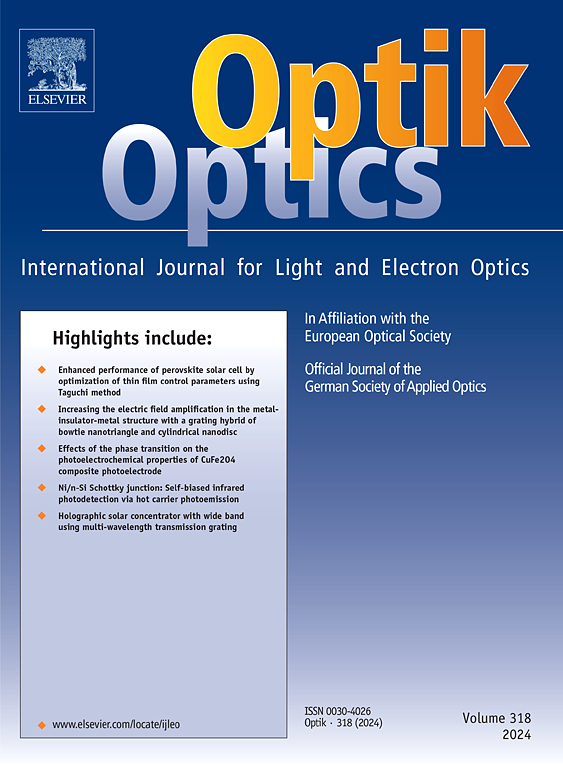A terahertz multiband metamaterial based rectangular loop antenna with 2×2 split ring resonator arrays and photonic band gap structures
IF 3.1
3区 物理与天体物理
Q2 Engineering
引用次数: 0
Abstract
The THz frequency band, ranging from 0.1 THz to 10 THz, is gaining increasing attention dueto its ability to provide high bandwidth, making it ideal for a wide range of emerging applications, including high-speed wireless communication systems. However, designing wireless devices for this band requires meeting stringent criteria such as sustainability, environmental resilience, flexibility, and cost-effectiveness. These challenges have driven the exploration of new materials and advanced design strategies to optimize performance while fulfilling these essential requirements. This study presents the design of a THz antenna that integrates Metamaterial (MTM) structures, 2 × 2 Split-Ring Resonator (SRR) arrays, and Photonic Band Gap (PBG) structures to enhance its overall performance. The proposed rectangular loop antenna, featuring compact dimensions of 240 µm × 230 µm × 45 µm for Kapton and 255 µm × 355 µm × 45 µm for Quartz Fabric, exhibits a multiband response with distinct resonances centered at 0.47 THz, 0.85 THz, and 1.1 THz for the Kapton-based design, and at 0.5 THz and 0.88 THz for the Quartz Fabric-based design. These responses effectively cover the 0.4–1.2 THz frequency range. The multiband behavior of the antenna significantly broadens its potential applications across various fields, including biomedical imaging, security and threat detection, THz spectroscopy, THz communications, non-destructive testing (NDT), and agriculture and food quality monitoring. Furthermore, the use of environmentally friendly and cost-effective materials, such as single-walled carbon nanotubes (SWCNTs), offers a promising pathway toward the development of sustainable, high-performance antennas. The antenna exhibits excellent impedance matching, with S11 values ensuring efficient energy transfer and minimal reflection across the operating frequency range. A comprehensive parametric study reveals significant bandwidth improvements, with Kapton achieving a bandwidth of 45–51 GHz and a realized gain of 2.95 dBi, while Quartz Fabric achieves 45–48 GHz with a realized gain of 3.71 dBi. These results confirm that the integration of MTM and PBG structures substantially enhances the antenna’s performance in terms of bandwidth, gain, and efficiency.
一种具有2×2分环谐振器阵列和光子带隙结构的太赫兹多波段超材料矩形环形天线
太赫兹频段,范围从0.1 太赫兹到10 太赫兹,由于其提供高带宽的能力而受到越来越多的关注,使其成为包括高速无线通信系统在内的各种新兴应用的理想选择。然而,为这一频段设计无线设备需要满足严格的标准,如可持续性、环境弹性、灵活性和成本效益。这些挑战推动了新材料和先进设计策略的探索,以优化性能,同时满足这些基本要求。本研究提出了一种集成了超材料(MTM)结构、2个 × 2个分环谐振器(SRR)阵列和光子带隙(PBG)结构的太赫兹天线的设计,以提高其整体性能。拟议中的矩形环形天线,紧凑的尺寸240 µm×230 µm× 45 µm聚酰亚胺薄膜和255年 µm×355 µm× 45 µm石英织物,展品多波段响应有明显共振 太赫兹集中在0.47,0.85 太赫兹,和1.1 太赫兹Kapton-based设计,在0.5 太赫兹和0.88 太赫兹石英基于结构设计。这些响应有效地覆盖了0.4-1.2 太赫兹频率范围。天线的多波段特性显著拓宽了其在各个领域的潜在应用,包括生物医学成像、安全和威胁检测、太赫兹光谱、太赫兹通信、无损检测(NDT)以及农业和食品质量监测。此外,使用环境友好且具有成本效益的材料,如单壁碳纳米管(SWCNTs),为开发可持续的高性能天线提供了一条有希望的途径。该天线具有出色的阻抗匹配,其S11值确保了在整个工作频率范围内有效的能量传输和最小的反射。综合参数研究显示了显著的带宽改进,Kapton实现了45-51 GHz的带宽和2.95 dBi的实现增益,而石英织物实现了45-48 GHz的实现增益为3.71 dBi。这些结果证实了MTM和PBG结构的集成在带宽、增益和效率方面大大提高了天线的性能。
本文章由计算机程序翻译,如有差异,请以英文原文为准。
求助全文
约1分钟内获得全文
求助全文
来源期刊

Optik
物理-光学
CiteScore
6.90
自引率
12.90%
发文量
1471
审稿时长
46 days
期刊介绍:
Optik publishes articles on all subjects related to light and electron optics and offers a survey on the state of research and technical development within the following fields:
Optics:
-Optics design, geometrical and beam optics, wave optics-
Optical and micro-optical components, diffractive optics, devices and systems-
Photoelectric and optoelectronic devices-
Optical properties of materials, nonlinear optics, wave propagation and transmission in homogeneous and inhomogeneous materials-
Information optics, image formation and processing, holographic techniques, microscopes and spectrometer techniques, and image analysis-
Optical testing and measuring techniques-
Optical communication and computing-
Physiological optics-
As well as other related topics.
 求助内容:
求助内容: 应助结果提醒方式:
应助结果提醒方式:


